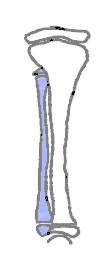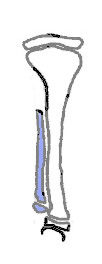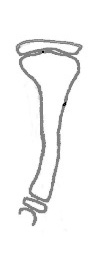Fibular hemimelia
Fibular hemimelia (hemi·me·lia) is a developmental anomaly characterized by absence of all or part of the fibula.
Fibula- hypoplasia (hy·po·pla·sia): incomplete fibula development.
Fibula-aplasia (a·pla·sia): complete absence of fibula.
Fibular hemimelia is often associated with additional malformations of tarsus and / or axial malformations of the feet (lack of toes on the foot). In the case of a complete or partial fibula deficiency the ankle no longer holds tarsal bones so the foot "dangles around" (lateral luxation). Fibular hemimelia is always associated with inferior growth of a shin. Due to strong tightening of connective tissue of the leaf bone (fibular fibrous connective fibers), most likely, often comes up an antecurvature (bending) of tibia.

It is the most common long bone congenital defect. It occurs in 7.4 to 20 cases per million births. The cause is still unknown. The severity depends on the extent of the fibular defect.
There are many classifications for fibular hemimelia. Although not very appropriate for the therapy, a practical classification was proposed by ACHTERMAN & KALAMCHI. This classification uses the length deficiency of the fibula.
Type I (fibular hypoplasia): includes all fibular hemimelia in which a portion of the fibula is present. This group is subdivided according to the extent of the deficiency.
In type Ia the proximal fibular epiphysis lays distal to the level of the tibial growth plate and is smaller than on the normal side on x-ray films.
In type Ib the proximal fibula is absent on x-ray films.
In type II (fibular aplasia) the fibula is entirely absent on x-ray films.
 |
 |
 |
| Type Ia | Type Ib | Type II |
Fibular hemimelia is often associated with:
- Leg length discrepancy
- Femoral deficiencies
- Lateral femoral condyle hypoplasia
- Hypoplasia of patella
- Knee instability
- Knee flexion contracture
- Absence of ACL (anterior cruciate ligament) and/or PCL (posterior cruciate ligament)
- Anterolateral bowing of the tibia
- Ball-and-socket ankle
- Equinovalgus deformity of the foot
- Missing lateral rays
- Other deformities of hindfoot and forefoot
In a few cases it can also be accompanied with the defect of ulna (a bone of forearm); in these cases it is called FFU-Syndrome.
Clinical Presentation: Children with partial or complete absence of fibula present, depending on the severity of a disease, a shorter lower extremity. The knee shows an increased mobility. At the point of the greatest angulation, there is an anterior bowing of a distal third of the tibia with a dimple in the skin. The foot can be twisted out of shape or position, with lacking of one or more toes. The heel can be elevated and turned outward from the midline of the body. If there is a bilateral involvement of the fibula, the leg length discrepancy between the two lower extremities is usually insignificant. However, there is a disproportion between the length of the lower limbs and the trunk.
Patients are otherwise of a very good health, and show no further affection. The mental development is normal.









